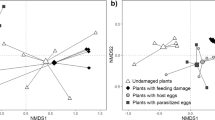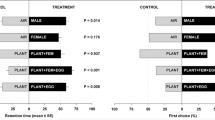Parasitoids are confronted with many different infochemicals of their hosts and food plants during host selection. Here, we investigated the effect of kairomones from the adult host Pieris brassicae and of cues present on Brussels sprout plants infested by P. brassicae eggs on the behavioral response of the egg parasitoid Trichogramma evanescens. Additionally, we tested whether the parasitoid’s acceptance of P. brassicae eggs changes with different host ages. The wasps did not discriminate between olfactory cues from mated and virgin females or between mated females and males of P. brassicae. T. evanescens randomly climbed on the butterflies, showing a phoretic behavior without any preference for a certain sex. The parasitoid was arrested on leaf parts next to 1-day-old host egg masses. This arrestment might be due to cues deposited during oviposition. The wasps parasitized host eggs up to 3 days old equally well. Our results were compared with former studies on responses by T .brassicae showing that T. evanescens makes less use of infochemicals from P. brassicae than T. brassicae.



Similar content being viewed by others
REFERENCES
Andersson, J., Borg-Karlson A.-K., and Wiklund C. (2003). Antiaphrodisiacs in Pierid butterflies: a theme with variation! J. Chem. Ecol. 29: 1489–1499.
Bjorksten T. A., and Hoffmann A. A. (1995). Effects of pre-adult and adult experience on host acceptance in choice and non-choice tests in two strains of Trichogramma. Entomol. Exp. Appl. 76: 49–58.
Bjorksten T. A., and Hoffmann A. A. (1998). Persistence of experience effects in the parasitoid Trichogramma nr. brassicae. Ecol. Entomol. 23:110–117.
Bruni, R., SantAna J., Aldrich, J. R., and Bin F. (2000). Influence of host pheromone on egg parasitism by scelionid wasps: Comparison of phoretic and nonphoretic parasitoids. J. Insect Behav. 12: 165–173.
Fatouros, N. E. (2006). Parasitic Wasps on Butterfly Expedition. Foraging Strategies of Egg and Larval Parasitoids Exploiting Infochemicals of Brussels Sprouts and Their Pieris Hosts, (Ph.D. thesis). Berlin: Freie Universität Berlin. 181 p.
Fatouros, N. E., Bukovinszkine’Kiss, G., Kalkers, L. A., Soler Gamborena, R., Dicke, M., and Hilker, M. (2005a). Oviposition-induced plant cues: do they arrest Trichogramma wasps during host location? Entomol. Exp. Appl. 115: 207–215.
Fatouros, N. E., Huigens, M. E., van Loon, J. J. A., Dicke, M., and Hilker, M. (2005b). Chemical communication - Butterfly anti-aphrodisiac lures parasitic wasps. Nature 433: 704.
Hilker, M., and Meiners, T. (2002). Induction of plant responses towards oviposition and feeding of herbivorous arthropods: a comparison. Entomol. Exp. Appl. 104: 181–192.
Hilker, M., and Meiners, T. (2006). Early herbivore alert: Insect eggs induce plant defense. J. Chem. Ecol. 32: 1379–1397.
Jones, R. L., Lewis, W. J., Beroza, M., Bierl, B. A., and Sparks, A. N. (1973). Host-seeking stimulants (kairomones) for the egg parasite, Trichogramma evanescens. Envirom. Entomol. 2: 593–596.
Kaiser, L., Pham-Delegue, M. H., and Masson, C. (1989). Behavioural study of plasticity in host preferences of Trichogramma maidis (Hym.: Trichogrammatidae). Physiol. Entomol. 14: 53–60.
Lewis, W. J., Vet, L. E. M., Tumlinson, J. H., van Lenteren, J. C., and Papaj, D. R. (2003). Variations in natural-enemy foraging behaviour: Essential element of a sound biological control theory. In Van Lenteren J. C. (ed.), Quality Control and Production of Biological Control Agents: Theory and Testing Procedures, CAB Publisher, Wallingford, pp. 41–58.
Noldus, L. P. J. J. (1989). Semiochemicals, foraging behaviour and quality of entomophagous insects for biological control. J. Appl. Ent. 108: 425–451.
Noldus, L. P. J. J., and van Lenteren, J. C. (1985a). Kairomones for the egg parasite Trichogramma evanescens Westwood I. Effect of volatile substances released by two of its hosts, Pieris brassicae L. and Mamestra brassicae, L. J. Chem. Ecol. 11: 781–791.
Noldus, L. P. J. J., and van Lenteren, J. C. (1985b). Kairomones for the egg parasite Trichogramma evanescens Westwood II. Effect of contact chemicals produced by two of its hosts, Pieris brassicae L. and Pieris rapae L. J. Chem. Ecol. 11: 793–800.
Pak, G. A. (1988). Selection of Trichogramma for inundative biological control, (Ph.D. thesis). Wageningen, The Netherlands: Wageningen Agricultural University. 224 p.
Pak, G. A., Buis, H., Heck, I. C. C., and Hermans, M. L. G. (1986). Behavioral Variations Among Strains Of Trichogramma Spp -- Host-Age Selection. Entomol. Exp. Appl. 40: 247–258.
Pak, G. A., and De Jong, E. J. (1987). Behavioral variations among strains of Trichogramma spp – Host recognition. Neth. J. Zool. 37: 137–166.
Pak, G. A., Kaskens, J. W. M., and Dejong, E. J. (1990). Behavioral variation among strains of Trichogramma spp - Host-species selection. Entomol. Exp. Appl. 56: 91–102.
Pimentel, D., Smith, G. J. C., and Soans, J. (1967). A population model to sympatric speciation. Am. Nat. 101: 493–504.
Pinto, J. D., and Stouthamer, R. (1994). Systematics of Trichogrammatidae with emphasis on Trichogramma. In Wajnberg E., Hassan S. A. (eds.), (Biological Control with Egg parasitoids, CAB international, Oxon, pp. 1–36.
Romeis, J., Babendreier, D., Wäckers, F. L., and Shanower, T. G. (2005). Habitat and plant specificity of Trichogramma egg parasitoids—underlying mechanisms and implications. Basic Appl. Ecol. 6: 215–236.
Rutledge, C. E. (1996). A survey of identified kairomones and synomones used by insect parasitoids to locate and accept their hosts. Chemoecology 7: 121–131.
Smith, S. M. (1996). Biological control with Trichogramma: Advances, successes, and potential of their use. Ann. Rev. Entomol. 41: 375–406.
Steidle, J. L. M., and Schoeller, M. (1997). Olfactory host location and learning in the granary weevil parasitoid Lariophagus distinguendus (Hymenoptera: Pteromalidae). J. Insect Behav. 10: 331–342.
Stouthamer, R., Hu, J., Kan, v. F. J. P. M., Platner, G. R., and Pinto, J. D. (1999). The utility of internally transcribed spacer 2 DNA sequences of nuclear ribosomal gene for distinguishing sibling species of Trichogramma. BioControl 43: 421–440.
van Dijken, M. J., Kole, M., van Lenteren, J. C., and Brand, A. M. (1986). Host-preference studies with Trichogramma evanescens Westwood (Hym., Trichogrammatiedae) for Mamestra brassicae, Pieris brassicae and Pieris rapae. J. Appl. Entomol. 101: 64–85.
Vinson, S. B. (1991). Chemical signals used by parasitoids. Redia 74: 15–42.
Wajnberg, E., and Hassan, S. A. (1994). Biological Control with Egg Parasitoids, CAB International, Wallingford, Oxon, UK.
ACKNOWLEDGMENTS
The authors thank Katja Hoedjes and Linda Tiggelman for their help with some of the experiments, Martinus E. Huigens for comments on a previous version of the manuscript, Leo Koopman, Frans van Aggelen, and André Gidding for culturing the insects, and the experimental farm of Wageningen University (Unifarm) for breeding and providing the Brussels sprout plants. The study was financially supported by the Deutsche Forschungsgemeinschaft (Hi 416/15–1, 2).
Author information
Authors and Affiliations
Corresponding author
Rights and permissions
About this article
Cite this article
Fatouros, N.E., Bukovinszkine’Kiss, G., Dicke, M. et al. The Response Specificity of Trichogramma Egg Parasitoids towards Infochemicals during Host Location. J Insect Behav 20, 53–65 (2007). https://doi.org/10.1007/s10905-006-9062-z
Published:
Issue Date:
DOI: https://doi.org/10.1007/s10905-006-9062-z




